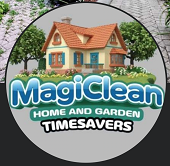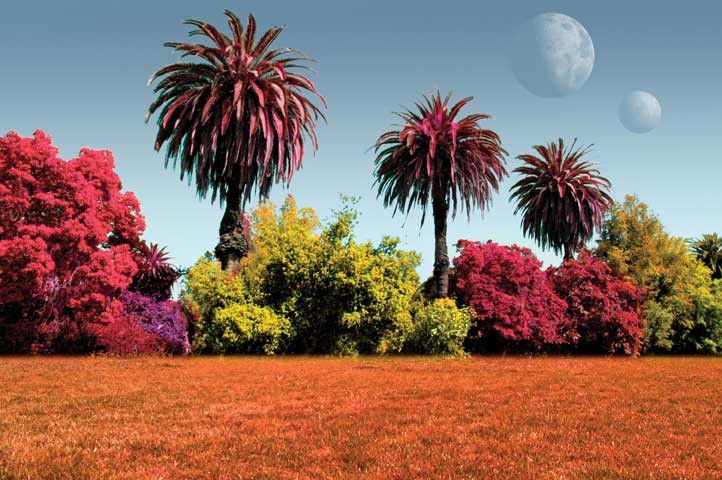What Color Would Alien Vegetation Be? – The Unconventional Gardener
Header picture: An illustration of what crops might seem like on totally different planets. Picture credit score: Doug Cummings, Caltech.
When he wrote The Battle of the Worlds within the late nineteenth century, science fiction author H. G. Wells imagined that crops would look totally different on Mars: “The vegetable kingdom in Mars, as a substitute of getting inexperienced for a dominant color, is of a vivid blood-red tint.”
Whereas we now know there’s no plants on Mars, there are many different planets within the Universe that may be extra hospitable. And in 2007, NASA scientists discovered a solution to predict the color of crops on exoplanets (planets in different photo voltaic methods). After learning gentle absorbed and mirrored by organisms on Earth, they decided that some planets may have principally non-green crops.
“We are able to determine the strongest candidate wavelengths of sunshine for the dominant shade of photosynthesis on one other planet.”
Nancy Kiang, lead writer of the examine and a biometeorologist at NASA’s Goddard Institute for Area Research, New York.

“This work broadens our understanding of how life could also be detected on Earth-like planets round different stars, whereas concurrently enhancing our understanding of life on Earth. This strategy — learning Earth life to information our seek for life on different worlds — is the essence of astrobiology.”
Carl Pilcher, director of the NAI at NASA Ames
Photosynthesis on Earth

Kiang and colleagues surveyed gentle absorbed and mirrored by crops and a few micro organism on Earth throughout photosynthesis, a course of by which crops use power from daylight to supply sugar. Organisms that dwell in numerous gentle environments take in the sunshine colors which might be most obtainable. For instance, a kind of micro organism that inhabits murky waters the place there may be little seen gentle makes use of infrared radiation throughout photosynthesis.
Scientists have lengthy recognized that the chlorophyll in most crops on Earth absorbs blue and pink gentle and fewer inexperienced gentle. Due to this fact, chlorophyll seems inexperienced. Though some inexperienced color is absorbed, it’s lower than the opposite colors. Beforehand, scientists thought crops should not environment friendly as they may very well be, as a result of they don’t use extra inexperienced gentle.
The Solar has a selected distribution of colors of sunshine, emitting extra of some colors than others. Gases in Earth’s air additionally filter daylight, absorbing totally different colors. Because of this, extra pink gentle particles attain Earth’s floor than blue or inexperienced gentle particles, so crops use pink gentle for photosynthesis. There may be loads of gentle for land crops, so they don’t want to make use of further inexperienced gentle. However not all stars have the identical distribution of sunshine colors as our Solar. Scientists realised that photosynthesis on extrasolar planets might not look the identical as on Earth.
Plant Colors Elsewhere within the Universe

Kiang and her colleagues calculated what the stellar gentle would seem like on the floor of Earth-like planets whose atmospheric chemistry is in keeping with the several types of stars they orbit. By wanting on the modifications in that gentle by way of totally different atmospheres, researchers recognized colors that will be most beneficial for photosynthesis on different planets. This new analysis narrows the vary of colors that scientists would count on to see when photosynthesis is happening on extrasolar planets. Every planet could have totally different dominant colors for photosynthesis, primarily based on the planet’s ambiance the place essentially the most gentle reaches the planet’s floor. The dominant photosynthesis would possibly even be within the infrared.
“This work will assist information designs for future house telescopes that may examine extrasolar planets, to see if they’re liveable, and will have alien crops.”
Victoria Meadows, an astronomer who headed a VPL utilizing a set of laptop fashions to simulate Earth-size planets and their gentle spectra as house telescopes would see them. Their objective was to find the possible vary of liveable planets round different stars and to learn how these planets would possibly seem to future planet-finding missions.
“It seems that harvesting blue gentle is quite common throughout the board for photosynthetic organisms. I believe it’s unlikely that something will probably be blue,” mentioned Kiang.
“It makes one recognize how life on Earth is so intimately tailored to the particular qualities of our house planet and Solar.”
References and additional studying:
Nancy Y. Kiang, “The Colour of Life, on Earth and on Extrasolar Planets”, NASA Goddard Institute for Area Research, April 2007. https://www.giss.nasa.gov/analysis/briefs/archive/2007_kiang_01/
NASA, “NASA Predicts Non-Inexperienced Vegetation on Different Planets”, NASA Information & Characteristic Releases, April 2007. https://www.giss.nasa.gov/analysis/information/archive/20070411/
James Randerson, “Alien ‘crops’ may very well be purple or yellow, say Nasa scientists”, The Guardian, April 2007 https://www.theguardian.com/science/2007/apr/11/spaceexploration.crops
Jeff Hecht, “For crops on alien worlds, it isn’t simple being inexperienced”, New Scientist, April 2007. https://www.newscientist.com/article/dn11578-for-plants-on-alien-worlds-it-isnt-easy-being-green/
Ker Than, “Colourful Worlds: Vegetation on Different Planets May Not Be Inexperienced”. Area.com, April 2007. https://www.house.com/3680-colorful-worlds-plants-planets-green.html
Heidi Ledford, “Alien crops might are available in all colors however blue” Nature, April 2007. https://www.nature.com/information/2007/070409/full/news070409-7.html
Kiang, Nancy Y. “The colour of crops on different worlds.” Scientific American. April 2008). https://physics.ucf.edu/~britt/AST2002/R3-Kiang-Colorpercent20ofpercent20plantspercent20onpercent20otherpercent20worlds.pdf
Except in any other case acknowledged, © Copyright Emma Doughty 2024. Revealed on theunconventionalgardener.com.
When you loved this submit, please contemplate supporting my work. I’ve a subscriber-only Patreon for house plant fanatics, or you might simply purchase me a cup of tea:
Many thanks!


















